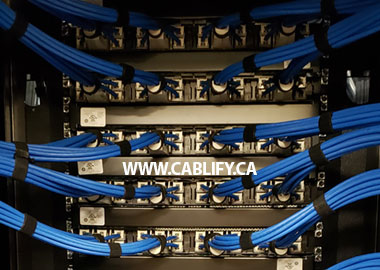When it comes to networking, understanding the capabilities and limitations of different cable types is vital. In this guide, we’ll be comparing the range, speed, and other characteristics of several types of Ethernet cables (Cat5e, Cat6, Cat6a, and Cat7) and fiber optic cables (single-mode and multi-mode).
Network cabling serves as the lifeblood of any data network. From the consumer level to the enterprise, there is a wide array of cable types that one can utilize based on different networking needs, such as speed, distance, and environment. Among the most common options are the Ethernet cable categories (Cat5e, Cat6, Cat6a, and Cat7) and fiber optic cable types (single-mode and multi-mode).
Each of these cable types has its own unique specifications that make it more or less suited for different networking applications. Understanding these specifications and how they correlate with the requirements of a network can aid in the selection of the most appropriate and cost-effective solution.
Ethernet Cables
Ethernet cables have been the most prevalent form of network cabling for many years, particularly in the local area network (LAN) environment. Over time, these cables have evolved from the original Category 3 (Cat3) to more advanced forms like Cat5e, Cat6, Cat6a, and Cat7.
Cat5e (Category 5 enhanced)
Cat5e, an enhanced version of Cat5, has become the standard for modern networking due to its performance characteristics and affordability.
- Maximum Data Rate: 1 Gbps (1000 Mbps)
- Maximum Bandwidth: 100 MHz
- Maximum Distance: 100 meters (328 feet) for a single cable run
Cat6 (Category 6)
Cat6 offers higher performance compared to Cat5e. It’s designed for use in networks that need to handle higher data volumes and higher speeds.
- Maximum Data Rate: 10 Gbps, but only up to 55 meters (180 feet)
- Maximum Bandwidth: 250 MHz
- Maximum Distance: 100 meters (328 feet), but for 10 Gbps, it reduces to 55 meters
Cat6a (Category 6 Augmented)
Cat6a, an advancement over Cat6, can handle even higher data rates over longer distances.
- Maximum Data Rate: 10 Gbps
- Maximum Bandwidth: 500 MHz
- Maximum Distance: 100 meters (328 feet) for a full 10 Gbps throughput
Cat7 (Category 7)
Cat7 is designed for use in very high-speed networks, supporting higher bandwidths than Cat6a.
- Maximum Data Rate: 10 Gbps
- Maximum Bandwidth: 600 MHz
- Maximum Distance: 100 meters (328 feet) for a full 10 Gbps throughput
Here’s a table summarizing the Ethernet cables:
| Cable Type | Max Data Rate | Max Bandwidth | Max Distance |
|---|---|---|---|
| Cat5e | 1 Gbps | 100 MHz | 100m |
| Cat6 | 10 Gbps | 250 MHz | 55m @ 10Gbps, 100m otherwise |
| Cat6a | 10 Gbps | 500 MHz | 100m |
| Cat7 | 10 Gbps | 600 MHz | 100m |
Fiber Optic Cables
Unlike Ethernet cables, which transmit data via electrical signals, fiber optic cables use pulses of light. This gives them several advantages, such as faster speeds, longer distances, and immunity to electromagnetic interference.
Single-Mode Fiber
Single-mode fiber (SMF) uses a single light mode to transmit data, allowing it to travel long distances with little signal loss.
- Maximum Data Rate: Up to 100 Gbps and beyond
- Maximum Distance: Up to 40 km (24.85 miles) for 10 Gbps, 100 km (62.14 miles) or more for lower speeds, depending on the specific transceiver used
Multi-Mode Fiber
Multi-mode fiber (MMF) can handle multiple light modes, making it more suitable for shorter distances due to modal dispersion.
- Maximum Data Rate: Up to 100 Gbps and beyond
- Maximum Distance: Typically up to 600 meters (1968.5 feet) for 10 Gbps, shorter for higher speeds, depending on the specific transceiver used
Here’s a table summarizing the fiber optic cables:
| Cable Type | Max Data Rate | Max Distance |
|---|---|---|
| Single-Mode | 100 Gbps+ | Up to 40 km @ 10 Gbps, 100 km+ @ lower speeds |
| Multi-Mode | 100 Gbps+ | Up to 600 m @ 10 Gbps, shorter @ higher speeds |
Comparison and Analysis
Understanding the differences between these cables can help you make the right decision for your network.
Ethernet cables like Cat5e, Cat6, Cat6a, and Cat7 offer affordability and ease of installation. They are suitable for most LAN environments, especially where cable runs are relatively short (up to 100 meters). However, their susceptibility to interference and limitations in data rate and distance may make them unsuitable for certain applications, especially those requiring high-speed data transmission over longer distances.
In contrast, fiber optic cables can handle significantly higher data rates and can transmit data over much longer distances. They are also immune to electromagnetic interference. However, fiber optic cables are more delicate and expensive to install and maintain compared to Ethernet cables. As such, they are often used for backbone connections, long-haul networks, and situations where the highest possible data rates are required.
The choice of network cabling depends on your specific needs and circumstances, such as network speed requirements, the distance between network nodes, your budget, and the environment in which the network will operate.



